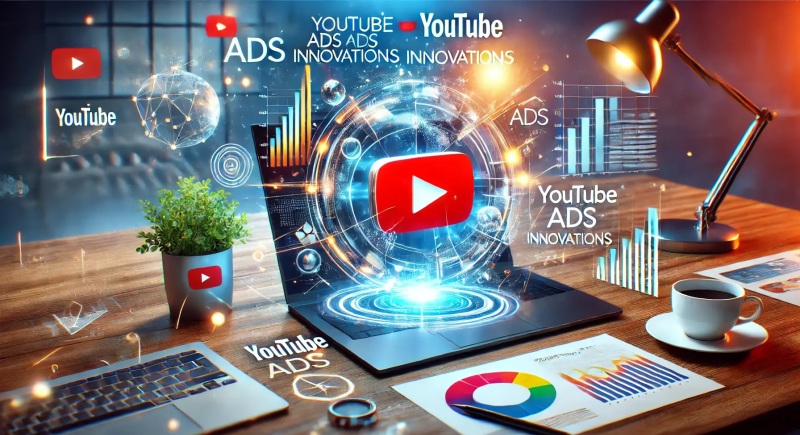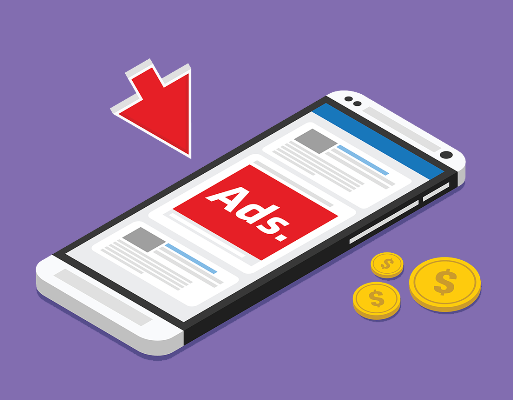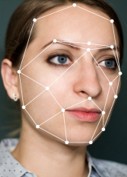
Think about the following questions.
1. How often do you see advertisements on your phone or other devices?
2. Are they often for products or services that interest you?
3. Do you think this is a more effective way to advertise than TV ads, for example? Why or why not?
VOCABULARY PREVIEW
Match each New Academic Word List(NAWL) word with the correct definition.
- sophisticated
- phenomenal _____
- interference _____
- execute _____
- non- _____
- retrieve _____
- a. used to add the meaning "not" or "the opposite of" to adjectives and nouns
- b. to do or perform something, especially in a planned way
- c. to find and bring back something
- d. extremely successful, special, and often surprising
- e. highly developed and complex
- f. something unwanted that stops people from doing what they are trying to do
DATA AND DIGITAL ADS

Digital advertising has become a phenomenal tool for companies that wish to communicate with customers and expand their sales. In 2015, US digital ad spending was equal to about fifty percent of US traditional ad spending. However, in recent years, digital ad spending has grown to account for forty-eight percent of US companies' total advertising expenditures1, meaning its value is almost equal to all other forms of advertising combined. Digital advertising's success can be credited2 to the many ways it's changed the industry. It's not only changed how ads are created and where they're presented but also who views specific ads and when.
Digital advertisements start with customer data and automation. Sophisticated automated programs collect people's online data to build profiles of potential customers. The collected data contains a wide range of information about each person, such as their contact details, transaction data, and web behavior. Once collected, this data is organized into data sets in a process called customer analytics3. These data sets inform advertisers of their customers' needs, concerns, interests, and more. They also give clues as to which messages, images, and videos would have the most appeal. To illustrate, consider your online shopping activities. Advertisers know which websites you look at most, how long you look at each product, and which brands you purchase. This information helps advertisers choose which platforms to use and what kinds of products to push.
Automation also does much of the heavy lifting for advertisers when connecting people with an ad. Automated programs communicate with other programs to retrieve a person's data and calculate which ads will have the maximum effect. This means that they can execute an ad strategy without direct human input. According to the Interactive Advertising Bureau (IAB), about twenty percent of digital advertising is done by one machine interacting with another. To illustrate this practice, have you ever looked up something like "best restaurants near me" on Google and then later find ads for restaurants on your Facebook account? That's targeted advertising, and it's implemented primarily by automated programs.
Digital advertising will continue to grow in importance as mobile devices multiply. As of 2019, there were over five billion unique mobile device users worldwide and 2.71 billion smartphone users. That's a huge audience. This is especially true in the US, where over eighty percent of the population owns a smartphone. A large audience isn't the only advantage gained from mobile devices. Advertisers also use mobile devices' geolocation4 technology to locate users and target them with local ads.
While technology has transformed advertising knowledge and delivery, it's also created some unique problems. Customers are shown so much advertising throughout their day that it's difficult for a company to stand out. Most people ignore pop-up ads, banner ads5, and texts. So advertisers have thought of more subtle ways to reach customers. This is where non-disruptive advertising comes into play. Non-disruptive advertising might sound like an oxymoron6 since we typically view ads as interference. However, these ads are disguised to be challenging to identify. For example, there's native advertising, which are ads that take the form of non-advertising content, such as infographics7 or "news" articles. If you ever see a "news" article about the health benefits of eating more hamburgers, keep an eye out for a fast-food logo somewhere on the page. Consumer advocates look at this and other clever digital advertising methods and point out that they raise concerns about deception8 and privacy on the internet. As a result, many are calling for digital advertising to be more heavily regulated9 by governments.
The primary driving force of change in advertising has always been technology. Printed ads gave way to television ads, and now television ads are giving way to digital ads. No matter the trend or medium, advertisers are evolving to stay competitive. Who knows what the future of advertising will bring.
New Academic Word List
- expenditure 1 : n. the total amount of money that an organization or person spends
- credit 2 : v. to say that (something) is because of (someone or something)
- analytics 3 : n. the process by which a computer examines information using math
- geolocation 4 : n. technology that shows where you are when you are using the internet, especially on a cell phone
- banner ad 5 : n. an advertisement that appears across the top of a page on the internet
- oxymoron 6 : n. two words used together that have, or seem to have, opposite meanings
- infographic 7 : n. a picture or diagram that explains information
- deception 8 : n. the act of misleading someone by making them believe something that is not true
- regulate 9 : v. to control an activity or process, especially by using rules
READING COMPREHENSION
A ‣ Mark each statement as true (T) or false (F) according to the reading.
- Companies spend more on digital ads than any other kind of advertising.
- True
- False
- Customer analytics are used to organize information for advertisers.
- True
- False
- Statistics show that five billion people worldwide owned smartphones in the late 2010s.
- True
- False
- Some advertisements are designed to look like pieces of journalism.
- True
- False
- Consumer advocates say the government should not interfere in online advertising.
- True
- False
B ‣ Choose the best answer according to the reading.
- What is the main purpose of the reading?
- a. To discuss the ways companies profit from digital advertising
- b. To explain how digital advertising agencies create brands
- c. To describe the ways digital advertisers reach consumers
- d. To examine how our digital data is used to improve online searches
- In paragraph 3, the word implemented is closest in meaning to _____.
- a. developed
- b. invented
- c. understood
- d. achieved
- What allows ads for nearby businesses to appear on your smartphone?
- a. Sponsored content
- b. Infographics
- c. Widespread mobile use
- d. Geolocation technology
- What can be inferred from paragraph 5?
- a. Customers do not mind being shown deceptive content.
- b. It is the law that all ads must be clearly marked as ads.
- c. Consumers tend to get tired of looking at advertisements.
- d. Non-disruptive advertising is not very effective.
C ‣ Fill in the blanks with information from the reading.
- The _____ suggests that about one-fifth of digital advertising is automated.
- Around four-fifths of Americans own a(n) _____ .
- _____ advertising is meant to be less annoying than regular advertising.
SUMMARY
Fill in the blanks with the phrases in the box.
- which websites
- targeted advertising
- communicate effectively
- where we are
- sorted into groups
- do not appear
Digital advertising is used by companies to 1 _____ with customers and increase their profits. They use automated systems to collect data which tells them our contact details, 2 _____ we look at, and which products we buy. This information is 3 _____ in a process called customer analytics. It is then used by automated programs to send us 4 _____. In addition to this information, advertisers can use geolocation to find out 5 _____ and send us advertisements for local shops and restaurants. The amount of ads people receive can mean that they find them annoying and begin not to look at them. Other types of advertising, like native ads, are less disruptive. In fact, often, they 6 _____ to be advertising at all.
VOCABULARY PRACTICE
Fill in the blanks with the words in the box. Change the form if necessary.
- retrieve
- phenomenal
- interference
- execute
- non-
- sophisticated
- The movie received _____ reviews, so millions of people went to see it.
- The gymnast _____ a perfect routine and won the gold medal.
- After Marge dropped her necklace down the drain, she used a magnet on a long piece of string to _____ it.
- Every year, technology companies release _____ new consumer products.
- _____ invasive surgery can help to cure patients' problems with a shorter recovery time.
- With less _____ from his editor, John found it easier to concentrate on his book.
SUPPLEMENTAL READING
Deep Fakes

The term "deep fake" describes videos or images that are edited by artificial intelligence (AI). Essentially, deep fakes are media created by Al that convincingly places a person, or part of a person, such as his or her face, into an image or video. Originally, this produced poor-quality images. However, deep-fake technology has now reached the point where it has many practical uses. Ad companies, in particular, are interested in the technology because it can give them a competitive edge.
One obvious application of deep fakes for advertisers is to recreate living and deceased celebrities. Doing so can run a company into legal issues, but when permission is granted, there are countless possibilities. For instance, in 2019, Goodby Silverstein & Partners created a deep fake of Salvador Dali for a video exhibition at the Dali Museum. Advertisers have even added deep-fake advertisements to television programs. In April 2020, a hit documentary about Michael Jordan called The Last Dance was released. It featured a deep-fake clip from the 1998 NBA finals. In the ad, the sports commentator Kenny Mayne interrupts his broadcast to make predictions about the 2020 documentary, tight jeans, and his TV network's partnership with an insurance company. The fashion industry is joining in as well, looking to use deep-fake programs to create fashion ads in which runway models' faces are replaced with our own. Social-media apps such as Snapchat have also added filters that utilize the technology.
Although relatively new, deep-fake media is definitely here to stay. Companies are already discovering its advantages in terms of development costs and accessibility. Perhaps in the future, deep-fake ads will become a regular form of advertisement.
Fill in the blanks with information from the reading.
- Deep fakes are produced by _____ that can add someone's face into another image or video.
- Deep fakes can be used to bring _____ celebrities back to life.
- A film about basketball called _____ included a deep-fake clip.

Leave a comment
Load more